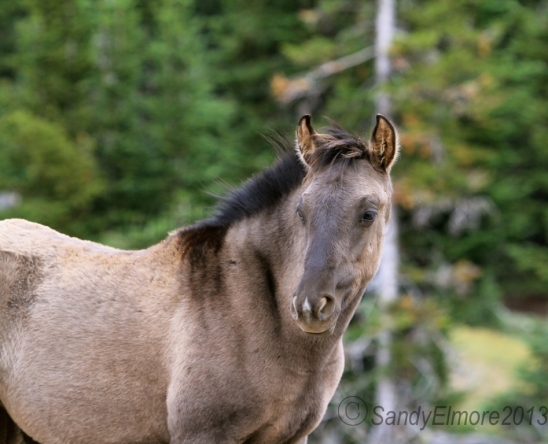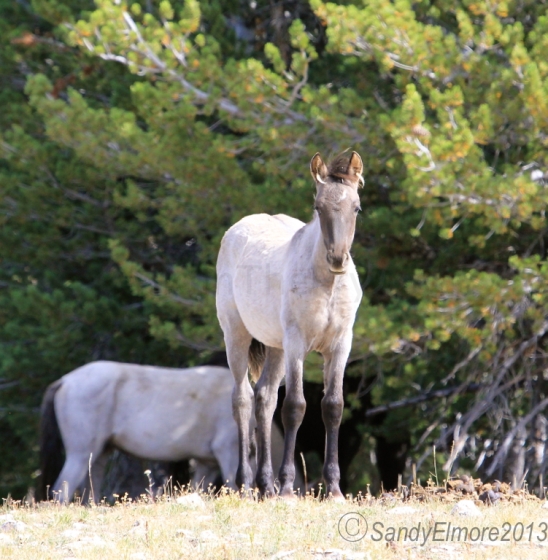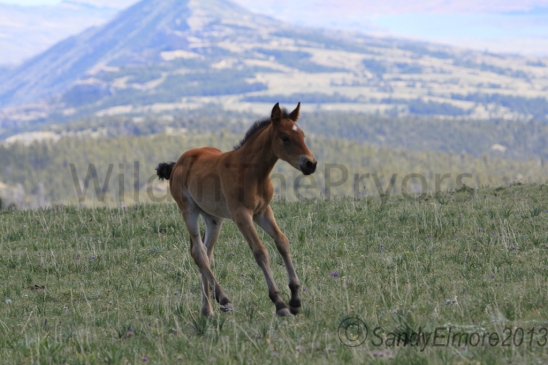Cross-posted from: http://wildinthepryors.com/2013/09/03/help-the-pryor-herd-today/
This is not just CLOUD’S HERD, but the PRYOR HERD. There are so many more horses that deserve just as much if not more attention. This herd is now in danger of being “managed to extinction” by PZP. A phrase that The Cloud Foundation used to live by.

Nye
In 2010 The Cloud Foundation released this:
Observations of PZP contraceptive use in the Pryors
Cross-posted from The Cloud Foundation
TCF does not support or recommend the continued use of the experimental immunocontraceptive drug, PZP, for the Pryor Wild Horse Herd because the drug continues to have an unusual and unpredictable impact on the mares that have received the drug.
PZP treatment was first administered to young females (seven yearlings and one two-year-old) in 2001 when they were given shots in the corrals after a roundup in September 2001. The drug was designed to extend one year of infertility to this group. It was given in two consecutive years. The second year the drug was administered via field darting.
Of these eight young mares, one died and four have foaled. The only two-year-old, Moshi, foaled in 2002, as she was already pregnant. Moshi didn’t foal again for 6 years until her out-of-season filly was born in September 2008.
Of the six remaining yearlings, four have produced a foal. Of the four foals, three were born in September. Administration of PZP was stopped on younger mares in 2005 due to a natural decrease in population largely because of mountain lion predation, and the unexpected absence of foal production by the young mares.
Nearly 50% of the young mares receiving the drug in the years 2001-2004 have never foaled. Of the 34 young mares to receive the drug between 2001-2004, 11 have died, 13 have foaled and 12 have not foaled. Two veterinarians (from Switzerland and Colorado) have independently expressed the same concern to us: mares not producing foals at a typically younger age (i.e. three-seven years) will have a more difficult time conceiving. They point out that this is true not just in horses but in humans as well as other species.
Of the 13 young mares that have foaled, eight foals have been born out of season, including three in September of 2008 alone. One foal born in September, never grew to full-size and was subsequently bait trapped and adopted out in September 2006. Another foal, born to Cecelia, #2224, a mare darted as a yearling and two-year-old in 2003 and 2004, was born in December of 2006. The majority of Pryor Mountain mares foal from May 15- June 15.She didn’t foal in 2007 and then foaled in September of 2008.
Photo evidence attests to the masculine and aggressive behavior of certain PZPed fillies as well as the masculine appearance of Aurora #2036. She has a stallion-like cresty neck and physique. It is obvious that the hormones of these young mares have been altered by PZP.
Of 21 older mares (11 years of age and older) given PZP from 2003-2007, 57% or 12 mares have foaled in spite of the field darting with Porcine Zona Pellucida. Only 43% or nine mares have not foaled (drug worked as designed). One mare, Tonopah #8603, produced a foal at the age of 21 in 2007.
Aside from the cruelty of raising a newborn foal going into a Montana winter, the drug has had other negative side effects in the form of abscesses, bleeding, and swelling on the hips of field darted mares. Of the 54 mares listed on the PMWHR Injection and Reaction Observations –updated June 2007 (BLM-03262), 41 mares are listed with swelling, nodules, bleeding or a combination of all these. 20 mares still have visible signs of nodules even years after they were injected. One mare, Hightail #8901, had an abscess from darting in 2007 which has since healed on its own.
Phoenix #9104 had a major wound at the location of an injection site lump from the last field darting prior to the observed wound. Photo comparisons indicate the wound, which appeared in June 2007 matches the left hip nodule from a previous darting with PZP. (Photos included). The mare and her foal were captured and treated in the corrals at the base of the mountain. Upon release to her band, the abscess looked to be healing although the mare had lost weight while in the Britton Springs corrals. Despite continued weight loss, the mare survived a long winter with deep snow at times, and looks remarkably fit at present.
The BLM has reported that density dependence (the ability for a wildlife population to self-regulate its numbers based on available resources) and compensatory reproduction (over-production by females to increase an under-represented population) have taken place on the Pryor Wild Horse Range. In other words the older mares that continue to reproduce despite the use of PZP are responding to an under-population. Generally the core reproducers as well as the older females share this burden. One older mare, Madonna #8913, who has been darted with PZP yearly since 2003, foaled in June 2007. The foal appeared to have trouble suckling and milk ran out its nose when nursing. The foal likely died during the night, as she was not with her mother the following morning.
To our knowledge this is the only herd in the West to receive PZP via field darts (Assateague Island off the coast of Virginia uses field darts with few reported problems). We believe that the many problems with swelling, bleeding and abscessing may be partially blamed on field darting. The projectile is shot through unclean surfaces on the hips of the mares.
Of the original group of young mares given the shot by hand while in the corrals, only one had any swelling. The other seven had no swelling, nodules or abscesses. This compares with 41 of 54 mares (a staggering 76%) with reported swelling, nodules and bleeding from at least one field darting experience. 43% of the mares darted in 2007 have nodules or bleeding and one mare had an abscess (Hightail #8901).
According to scientific reports, not all darts are recovered. Some needles may break off and remain in the mare where they could cause later abscessing. Significant problems may not be immediately observed, rather bacteria may linger and the problem area might be walled-off for some time then suddenly emerge as in the case of Phoenix #9104. This was mentioned as a possibility by four of the six equine veterinarians with whom we consulted. These veterinarians practice in California, Oregon, and Colorado and were asked for their opinions regarding the efficacy of field darting mares in the PMWHR, the potential hazards of this practice, and the possibility for a late abscess to appear months after the darting. One veterinarian expressed concern that the mare was darted again, thereby placing more strain on the immune system. Phoenix is one of the older mares who has produced a foal despite being darted.
Ironically, the initial stated reason for the administration of PZP by BLM was “purely from the standpoint of compassionate use”. Compassionate use was defined as “the use of the tool (or in this case a fertility control agent) to improve the quality of life of another (in this case younger or older wild mares).” (BLM Field Manager, Sandra S. Brooks-June 3, 2004). BLM sought to prolong the life of the older mares by causing them not to foal and to delay the foaling of the younger mares for one year.
The stated goal of the scientific community regarding an ideal wild horse fertility control agent was that it should be “at least 90% effective” (Wild Horse Contraceptive Research document, 1991 USGS website, posted 2-21-06). While the drug appears to be over 90% effective on Assateague Island, it has not performed in a similar manner in the Pryors. It has not prevented the foaling by a majority of the older mares and it has prevented foaling by the majority of the younger mares, in some cases, for seven years.
Most importantly, instead of trying to manage the Pryor Mountain Wild Horses in a natural way, allowing for a predator-prey balance and only conducting a roundup when truly necessary, wild horse managers opt for the use of PZP in combination with helicopter roundups and bait trapping. These policies threaten the health of the unique Spanish mustangs of the Pryor Mountains.
In addition to the statistical analysis of PZP use, it is hard not to comment on the social stress placed on both mares and their bands stallions when the mares cycle monthly and are repeatedly bred but do not settle. In July of 2008, we witnessed one young mare (#2315) being bred three times in a fifteen-minute period while she struggled to get away. Mares that cycle monthly attract the attention of bachelors and other band stallions on a regular basis and the stallion expends energy both in defense of his mare and in breeding her. This social unrest has not been reported on Assateague Island, but is easily observed in the Pryors, when individual horse bands come in close proximity to each other during the summer months.

Nirvana
Now they issue this:
|
|
| In 2012, 46 young Pryor horses were removed from their families and their home (including 7 foals). Some would have gone to BLM short-term holding corrals had it not been for TCF, our adopter friends, and particularly Lisa Friday & Legacy Mustang Preservation in Virginia. In all, we accounted for over half of those adopted. |
|
|
| But, we can’t continue to this as most of us have as many mustangs as our properties can sustain. And, TCF also rescues Pryor horses from previous adoptions which is an on-going process. Currently we have three horses looking for good, forever homes. |
|
| Adoption demand for mustangs is weak across the country. On the range management is the fiscal and humane solution—keeping wild horses on their ranges with their families where they are the safest. Of course, predator protection is what we continue to push for. |
|
|
| Nature is a better manager than we humans can ever be. But, in the meantime, the reversible vaccine, PZP, is the logical tool. It has proven to be safe, effective 90% of the time, and it is reversible. So, when predation or extreme killer storms occur, the field darting can be put on hold.We hope you’ll take time to read our comments and then formulate your own. |
|
Comments can be mailed or emailed. The address for mailing is:
Jim Sparks, Field Manager
5001 Southgate Drive
Billings, MT 59101-4669.Email is blm_mt_wildhorse@blm.gov. (Please note: spaces are underscores) |
|
|
Thanks for making your voices heard on behalf of Cloud and all the Pryor Mustangs!Happy Trails,
Ginger |
|
|
|

Maneulita
You can Click TCF to read the original post. I ask TCF to explain.
The Pryor Mountain Wild Mustang Center has released their comment and concerns for this proposal. These folks have had years more experience with these horses then TCF. I ask you to please read their comment and compare. Click on PMWMC to read it. Then ask yourself: ”Who Knows This Herd Best?”
This is the comment I sent in. While I do agree and work with PMWMC, I am still asking for no change to the current program at this time.
August 28, 2013
Jim Sparks, Field Manager BLM Billings Field Office 5001 Southgate Drive Billings, MT 59101
Dear Mr. Sparks,
I am writing in regard to the Bureau of Land Management’s recently released Pryor Mountain Wild Horse Range Fertility Control Modification Preliminary Environmental Assessment August 2013 (DOI-BLM-MT-0010-2013-0034-EA).
I am a Montana resident, permit holder (within the Pryor Range) and very frequent visitor to the Pryor Mountain Wild Horse Range.
I do not support the current Proposed Action in the Fertility Control Modification (2.1 Proposed Action) for the following reasons:
1. Long-term herd sustainability should be a primary management goal for the Pryor Mountain wild horses. The 2009 HMAP has stated that maintaining representation of all bloodlines is a major objective. The 2011 fertility control plan and 2012 gather plan have been consistent with this and the other objectives of the Plan, such as maintaining a core breeding age population.
2. By exposing fillies to PZP for four consecutive years there is an increased risk of sterility in this potential core breeding age group. (example would be Aurora, # 20036, who was primed as a yearling, vaccines in 2009 and has never foaled).
3. Allowing each mare to have only one descendant runs the risk of loss of important bloodlines and may greatly effect the genetics of this herd. This herd has a unique history and bloodlines, and preserving those bloodlines is very important. The Pryor Mountain Wild Horse Range is not the Assateague Island National Seashore, and so the fertility control plan developed there should not be assumed to be appropriate here.
4. I feel that the current fertility plan is beginning to show favorable results. Last year (2012) there were 25 foals born and this year (to date) only 15 (13 surviving). I would
like to see this current program remain in place. I would rather see small removals (of 10 or less) then to have a too aggressive fertility program that may greatly effect this herd.
5. One of the recent publications by an advocacy group, suggested there is no market for the adoption of Pryor Horses, and that was their reason for an increase in the PZP program. I disagree with that and realize that adoption should be a separate issue that should be addressed separately, not making it the reason to increase the current fertility plan. The PMWMC and I have discussed several ways that may help with a successful adoption and we plan to work together in the future to make that happen.
Thank you for considering my comment.
Sincerely,
Sandra P. Elmore
Wild In The Pryors

Mercuria
I ask you to please submit a comment against any changes to the program at this time.
You can send your comments to:
Jim Sparks, Field Manager BLM Billings Field Office 5001 Southgate Drive Billings, MT 59101
Or email to make sure it gets there:
blm_mt_wildhorse@blm.gov
Thank you.
Sandy


















